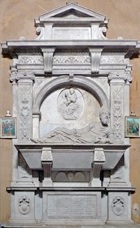Giovanni Antonio Dosio, who was born in Gimìgnano moved to Rome at the age of 16, and spent the period 1549-51 as an apprentice in the workshop of Raffaello da Montelupo. He seems to have had difficulty in establishing an independent as a sculptor: according to the account of his career in Raffaello Borghini's “Il Riposo” (1584), he scratched out a miserable living restoring Roman sculptures. This obviously paid dividends, because he soon established a reputation as an archeologist and antiquarian among the humanists of Rome.
In 1561, he worked in the Casina Pio IV of the Vatican Palace: this work apparently included the arrangement of the Roman statues displayed here. In 1562, he worked for the papal mercenary, Torquato Conti, who had purchased rights from the canons of SS Cosma e Damiano that allowed him to excavate the nearby site in the Roman forum. These excavations led to the discovery of the huge marble map of Rome (203-11 AD) known as the Forma Urbis. This lead to his commission was as an architect: he worked under Torquato Conti on the restoration of the fortifications of Anagni for Pope Pius IV in 1564-6.
Dosio left Rome for Florence in 1575. He published the “Urbis aedificiorum illustrium quae supersunt reliquiae” (1569), a collection of 50 engravings by Giovanni Batista de' Cavalieri of Dosio’s drawings of ancient remains in Rome. (This was dedicated to Duke Cosimo de' Medici of Florence in an abortive attempt to gain his patronage).
Dosio Florence for Naples in 1590 and died in nearby Caserta in 1611.
Amelia
A book of drawings (ca. 1559-65) by Giovanni Antonio Dosio, which survives in the Staatsbibliothek, Berlin, contains a view of Amelia dated May 1564 and a number of drawings of Roman objects in the city. It also contains a note of his itinerary in 1564: he left Orvieto in April for Amelia, where he stayed to work with Ippolito Scalza (see below), before leaving for Rome in July.
Monument of Bartolomeo II Farrattini (1561-4)

The epitaph of this monument commemorates Bartolomeo, Bishop of Chiusi, who had died at the age of 67 in 1534. It adds that the monument was commissioned by Bartolomeo’s nephews, the brothers Baldo, Simone Pietro and Fulvio Farrattini. (These nephews had also been his heirs). In the monument, the deceased lies in effigy on top of the sarcophagus. He is shown awake and gazing at the Farrattini Altarpiece (see below), which contains an image of his name saint. This type of effigy was newly-fashionable: the version here is close to that on the monument (1548) to Bishop Bernardino Elvino by Guglielmo della Porta in Santa Maria del Popolo, Rome. (I have not been able to find a photograph).
Baldo Farrattini built the chapel that housed both this monument and another that he commissioned from Ippolito Scalza for his own use. (It duly served this purpose when Baldo died in 1567). These monuments were visually linked to the Farrattini Altarpiece, which is attributed to Federico Zuccari. Each of these artists was, like Dosio, just beginning his independent career. The circumstances in which they probably gained these commissions are set out in the page on Cappella Farrattini.
Obviously, this project could not have been achieved in a few months in 1564: the factors that suggest the period 1561-4 are also set out in the page on Cappella Farrattini. There is nothing in the known movements of Giovanni Antonio Dosio that would preclude repeated visits to Amelia during this period, in addition to the documented visit of 1564.
Sketches in Amelia (ca. 1559-65)
As noted above, a book of drawings by Giovanni Antonio Dosio, which survives in the Staatsbibliothek, Berlin, contains a view of Amelia dated May 1564 and a number of drawings of Roman objects in the city. These include:
-
✴an important archaic Latin inscription (CIL XI 4348, 2nd century BC) from San Secondo, which has unfortunately been lost (and which is described in its wider context in the page Latin Inscriptions after 295 BC);
-
✴a cylindrical marble altar (1st century BC) from San Secondo, which is now in the Museo Archeologico;
-
✴a funerary urn (1st century BC) with an inscription (CIL XI, 4422) that records that Glaphyrus, the steward of a female member of the Roscia family, had commissioned it for a fellow-servant, Cinnamis, which which Dosio documented in a rural church outside Amelia and which is now in the Museo Archeologico;
-
✴a funerary Altar (1st century AD) commemorating Sessia Labionilla, which Dosio documented in Cappella Geraldini in the Duomo, and which is now in the Museo Archeologico;
-
✴a Roman relief embedded in Torre Civica, which depicts a scene from a marriage, and which probably came from a funerary monument.
Read more:
C. Valone, “ Giovanni Antonio Dosio: The Roman Years”, Art Bulletin 58 (1976) 528-41
Return to Art in: Amelia.
Return to “Foreign” Sculptors in Umbria.



